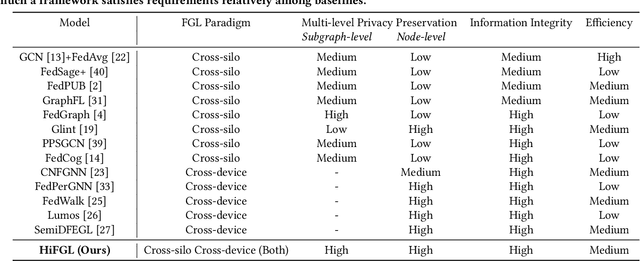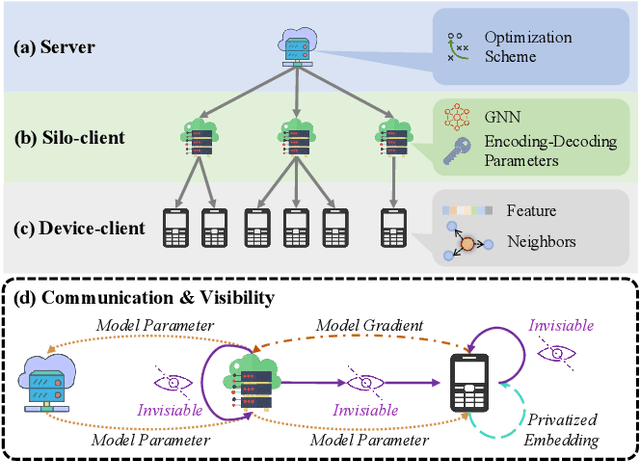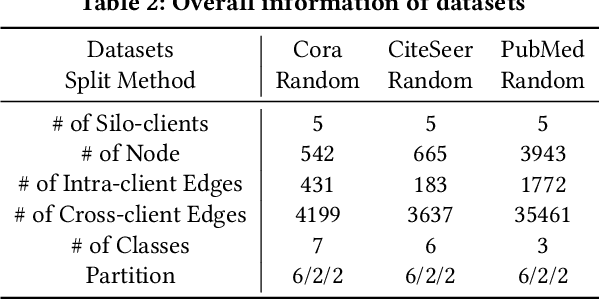Zhuoning Guo
GPU-accelerated Multi-relational Parallel Graph Retrieval for Web-scale Recommendations
Feb 17, 2025Abstract:Web recommendations provide personalized items from massive catalogs for users, which rely heavily on retrieval stages to trade off the effectiveness and efficiency of selecting a small relevant set from billion-scale candidates in online digital platforms. As one of the largest Chinese search engine and news feed providers, Baidu resorts to Deep Neural Network (DNN) and graph-based Approximate Nearest Neighbor Search (ANNS) algorithms for accurate relevance estimation and efficient search for relevant items. However, current retrieval at Baidu fails in comprehensive user-item relational understanding due to dissected interaction modeling, and performs inefficiently in large-scale graph-based ANNS because of suboptimal traversal navigation and the GPU computational bottleneck under high concurrency. To this end, we propose a GPU-accelerated Multi-relational Parallel Graph Retrieval (GMP-GR) framework to achieve effective yet efficient retrieval in web-scale recommendations. First, we propose a multi-relational user-item relevance metric learning method that unifies diverse user behaviors through multi-objective optimization and employs a self-covariant loss to enhance pathfinding performance. Second, we develop a hierarchical parallel graph-based ANNS to boost graph retrieval throughput, which conducts breadth-depth-balanced searches on a large-scale item graph and cost-effectively handles irregular neural computation via adaptive aggregation on GPUs. In addition, we integrate system optimization strategies in the deployment of GMP-GR in Baidu. Extensive experiments demonstrate the superiority of GMP-GR in retrieval accuracy and efficiency. Deployed across more than twenty applications at Baidu, GMP-GR serves hundreds of millions of users with a throughput exceeding one hundred million requests per second.
Against Multifaceted Graph Heterogeneity via Asymmetric Federated Prompt Learning
Nov 04, 2024Abstract:Federated Graph Learning (FGL) aims to collaboratively and privately optimize graph models on divergent data for different tasks. A critical challenge in FGL is to enable effective yet efficient federated optimization against multifaceted graph heterogeneity to enhance mutual performance. However, existing FGL works primarily address graph data heterogeneity and perform incapable of graph task heterogeneity. To address the challenge, we propose a Federated Graph Prompt Learning (FedGPL) framework to efficiently enable prompt-based asymmetric graph knowledge transfer between multifaceted heterogeneous federated participants. Generally, we establish a split federated framework to preserve universal and domain-specific graph knowledge, respectively. Moreover, we develop two algorithms to eliminate task and data heterogeneity for advanced federated knowledge preservation. First, a Hierarchical Directed Transfer Aggregator (HiDTA) delivers cross-task beneficial knowledge that is hierarchically distilled according to the directional transferability. Second, a Virtual Prompt Graph (VPG) adaptively generates graph structures to enhance data utility by distinguishing dominant subgraphs and neutralizing redundant ones. We conduct theoretical analyses and extensive experiments to demonstrate the significant accuracy and efficiency effectiveness of FedGPL against multifaceted graph heterogeneity compared to state-of-the-art baselines on large-scale federated graph datasets.
Labor Migration Modeling through Large-scale Job Query Data
Oct 03, 2024



Abstract:Accurate and timely modeling of labor migration is crucial for various urban governance and commercial tasks, such as local policy-making and business site selection. However, existing studies on labor migration largely rely on limited survey data with statistical methods, which fail to deliver timely and fine-grained insights for time-varying regional trends. To this end, we propose a deep learning-based spatial-temporal labor migration analysis framework, DHG-SIL, by leveraging large-scale job query data. Specifically, we first acquire labor migration intention as a proxy of labor migration via job queries from one of the world's largest search engines. Then, a Disprepant Homophily co-preserved Graph Convolutional Network (DH-GCN) and an interpretable temporal module are respectively proposed to capture cross-city and sequential labor migration dependencies. Besides, we introduce four interpretable variables to quantify city migration properties, which are co-optimized with city representations via tailor-designed contrastive losses. Extensive experiments on three real-world datasets demonstrate the superiority of our DHG-SIL. Notably, DHG-SIL has been deployed as a core component of a cooperative partner's intelligent human resource system, and the system supported a series of city talent attraction reports.
Convergence-aware Clustered Federated Graph Learning Framework for Collaborative Inter-company Labor Market Forecasting
Sep 29, 2024



Abstract:Labor market forecasting on talent demand and supply is essential for business management and economic development. With accurate and timely forecasts, employers can adapt their recruitment strategies to align with the evolving labor market, and employees can have proactive career path planning according to future demand and supply. However, previous studies ignore the interconnection between demand-supply sequences among different companies and positions for predicting variations. Moreover, companies are reluctant to share their private human resource data for global labor market analysis due to concerns over jeopardizing competitive advantage, security threats, and potential ethical or legal violations. To this end, in this paper, we formulate the Federated Labor Market Forecasting (FedLMF) problem and propose a Meta-personalized Convergence-aware Clustered Federated Learning (MPCAC-FL) framework to provide accurate and timely collaborative talent demand and supply prediction in a privacy-preserving way. First, we design a graph-based sequential model to capture the inherent correlation between demand and supply sequences and company-position pairs. Second, we adopt meta-learning techniques to learn effective initial model parameters that can be shared across companies, allowing personalized models to be optimized for forecasting company-specific demand and supply, even when companies have heterogeneous data. Third, we devise a Convergence-aware Clustering algorithm to dynamically divide companies into groups according to model similarity and apply federated aggregation in each group. The heterogeneity can be alleviated for more stable convergence and better performance. Extensive experiments demonstrate that MPCAC-FL outperforms compared baselines on three real-world datasets and achieves over 97% of the state-of-the-art model, i.e., DH-GEM, without exposing private company data.
HiFGL: A Hierarchical Framework for Cross-silo Cross-device Federated Graph Learning
Jun 15, 2024



Abstract:Federated Graph Learning (FGL) has emerged as a promising way to learn high-quality representations from distributed graph data with privacy preservation. Despite considerable efforts have been made for FGL under either cross-device or cross-silo paradigm, how to effectively capture graph knowledge in a more complicated cross-silo cross-device environment remains an under-explored problem. However, this task is challenging because of the inherent hierarchy and heterogeneity of decentralized clients, diversified privacy constraints in different clients, and the cross-client graph integrity requirement. To this end, in this paper, we propose a Hierarchical Federated Graph Learning (HiFGL) framework for cross-silo cross-device FGL. Specifically, we devise a unified hierarchical architecture to safeguard federated GNN training on heterogeneous clients while ensuring graph integrity. Moreover, we propose a Secret Message Passing (SecMP) scheme to shield unauthorized access to subgraph-level and node-level sensitive information simultaneously. Theoretical analysis proves that HiFGL achieves multi-level privacy preservation with complexity guarantees. Extensive experiments on real-world datasets validate the superiority of the proposed framework against several baselines. Furthermore, HiFGL's versatile nature allows for its application in either solely cross-silo or cross-device settings, further broadening its utility in real-world FGL applications.
A Cross-View Hierarchical Graph Learning Hypernetwork for Skill Demand-Supply Joint Prediction
Jan 31, 2024Abstract:The rapidly changing landscape of technology and industries leads to dynamic skill requirements, making it crucial for employees and employers to anticipate such shifts to maintain a competitive edge in the labor market. Existing efforts in this area either rely on domain-expert knowledge or regarding skill evolution as a simplified time series forecasting problem. However, both approaches overlook the sophisticated relationships among different skills and the inner-connection between skill demand and supply variations. In this paper, we propose a Cross-view Hierarchical Graph learning Hypernetwork (CHGH) framework for joint skill demand-supply prediction. Specifically, CHGH is an encoder-decoder network consisting of i) a cross-view graph encoder to capture the interconnection between skill demand and supply, ii) a hierarchical graph encoder to model the co-evolution of skills from a cluster-wise perspective, and iii) a conditional hyper-decoder to jointly predict demand and supply variations by incorporating historical demand-supply gaps. Extensive experiments on three real-world datasets demonstrate the superiority of the proposed framework compared to seven baselines and the effectiveness of the three modules.
Human Mobility Modeling During the COVID-19 Pandemic via Deep Graph Diffusion Infomax
Dec 12, 2022Abstract:Non-Pharmaceutical Interventions (NPIs), such as social gathering restrictions, have shown effectiveness to slow the transmission of COVID-19 by reducing the contact of people. To support policy-makers, multiple studies have first modeled human mobility via macro indicators (e.g., average daily travel distance) and then studied the effectiveness of NPIs. In this work, we focus on mobility modeling and, from a micro perspective, aim to predict locations that will be visited by COVID-19 cases. Since NPIs generally cause economic and societal loss, such a micro perspective prediction benefits governments when they design and evaluate them. However, in real-world situations, strict privacy data protection regulations result in severe data sparsity problems (i.e., limited case and location information). To address these challenges, we formulate the micro perspective mobility modeling into computing the relevance score between a diffusion and a location, conditional on a geometric graph. we propose a model named Deep Graph Diffusion Infomax (DGDI), which jointly models variables including a geometric graph, a set of diffusions and a set of locations.To facilitate the research of COVID-19 prediction, we present two benchmarks that contain geometric graphs and location histories of COVID-19 cases. Extensive experiments on the two benchmarks show that DGDI significantly outperforms other competing methods.
 Add to Chrome
Add to Chrome Add to Firefox
Add to Firefox Add to Edge
Add to Edge